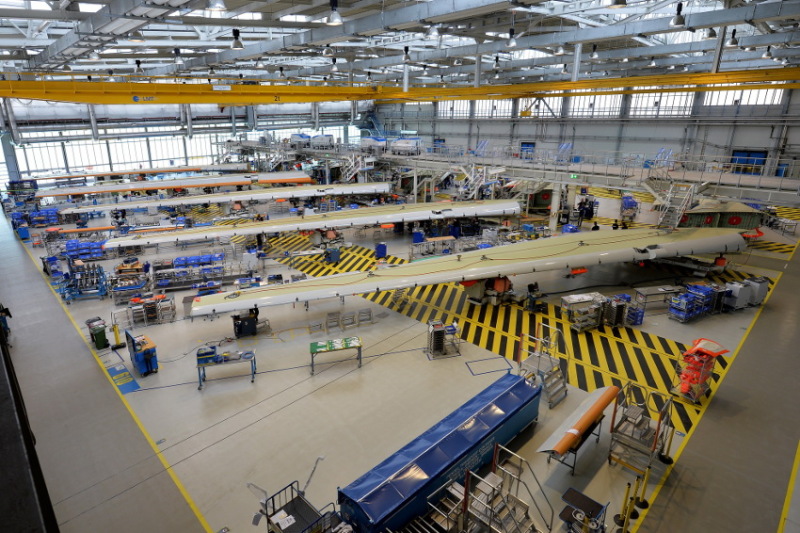Airbus’ site manager Dr André Walter: “For us, digitalisation means making work easier and more efficient”
Investing in BremenA growing use of digital technologies, 3D printing and collaboration between humans and robots is revolutionising construction in the aviation industry
A total of 4,500 employees work at the Airbus premises next to Bremen airport. The vast site also houses the space division of Airbus Defence and Space and their subsidiary supplier Premium Aerotec.
Even from the office of site manager Dr André Walter, it’s difficult to judge the sheer scale of the work that takes place here. For many companies, the future of digital manufacturing is just as difficult to predict. Yet for Walter, the course is perfectly clear – only the businesses that get ready for digitalisation today can be successful in the future.
Mr. Walter, what is the significance of digitalisation at Airbus?
Walter: For us, it’s not about implementing digital technologies for their own sake. Our manufacturing processes at Airbus already yield a wealth of data. The main question is whether we are making comprehensive use of this data at the moment. And are we using it in a networked fashion? With Industry 4.0 you have to ask yourself: “Is there a smart way of linking my data to improve the manufacturing process?” And this in turn only makes sense if the processes behind it are integrated as well. In our view, Industry 4.0, or digitalisation, means making work easier for employees and increasing efficiency.
What specific measures is the Airbus site in Bremen taking to increase production efficiency and reduce costs through digitalisation?
We have introduced a mixed model assembly line for wing manufacturing, after asking ourselves what would be the best way to manufacture wings for both the A330 and A350 on the same production line. Using this kind of manufacturing process, both sets of wings go through the same production chain. This can lead to significant organisational challenges, particularly with regard to components from different generations of products – the A350 was introduced only very recently, whereas the A330 has already been on the market for quite some time. We can only make this work if we are able to digitally monitor the manufacturing process. Low production cycle times place different kinds of demands on a digital factory than high production quantities – as is the case in the automotive industry, for example, where small, repetitive movements can be more easily carried out by robots.
How does Airbus approach this challenge?
Inevitably, we have to create synergies between man and machine. That’s why we’re looking into cobots – robots that work with and alongside human employees, both sharing the same workspace. Many of our areas require elaborate procedures that a robot would never be able to carry out alone. The kind of traditional assembly line production that you see in the automotive industry is virtually impossible for us.
How definite are the plans to introduce cobots?
We’re still in the trial phase. We aren’t using any at our Bremen site yet, but we are working closely with research institutes in Bremen to look at how they could be introduced. I don’t like the idea of immediately introducing new technologies to the site without thoroughly examining their benefits first. If we bring a new device into the factory and the employees don’t have the first clue what to do with it, then it won’t be of much help to us.

One technological development that demonstrates Airbus’ pioneering spirit is the use of Additive Layer Manufacturing (ALM). This 3D printing technique is used to create workpieces out of metal powder, and some of the first components it has produced are already in the air. What potential does Airbus see in this technology?
We are very interested in the technological applications of ALM. It enables you to quickly manufacture workpieces that are needed in small quantities – if you find that an individual component is missing during assembly, for example. ALM also provides a completely new way of designing components with great optimisation potential. How close is Airbus to implementing 3D printing in everyday operations? At the moment, 3D printing is only worthwhile when it comes to producing special parts. The technology would have to be more firmly established, the machines much faster and the powder significantly cheaper.
You’ve mentioned mixed model lines, cobots and 3D printing. Can you tell us about the innovation process that has led to these developments at Airbus?
Our manufacturing engineering unit, which acts an interface between development and production, has prepared us for the industrialisation of these technologies. The unit works closely with our information technology services, collaborating intensively on matters of automation and digitalisation. We also launched the ALM plateau* in Bremen in October 2015, where we are working with other companies to examine the various ways of using 3D printing technology. We are also working with Bremen-based partners such as the University of Bremen, the University of Applied Sciences, Jacobs University and other establishments in the area.
*Airbus uses the term ‘plateau’ to refer to a collaborative workspace for teams comprising members of multiple departments.

Airbus works closely with its partners here in Bremen. How well placed is the area with regard to new manufacturing technologies and digital, networked factories?
There are many outstanding research institutes and universities here, whose expertise we have to draw upon if we wish to bring Bremen’s network even further into the digital age. We can already see a community gradually developing as a result of this. Some studies say that up to half of all jobs could ultimately disappear as a result of digitalisation.
How realistic are these concerns?
Employees can be mistrustful of new technologies. However, we believe that the adoption of digital technologies empowers workers, enabling them to carry out their tasks better and more easily, more productively, and more ergonomically. It’s a fully integrated approach that can only be implemented when everyone is on board. Our first priority is to ensure that each individual worker is trained in line with the new working requirements. Businesses that address the issue of digitalisation head on can even expect to create more jobs – which means we have to start thinking now about how to secure the specialists we will need.
Which strategies does Airbus use to attract highly qualified specialists on a long-term basis?
Besides training the employees we already have, we have to ensure that the topic of digitalisation is explored in universities and in apprenticeships. Yet it’s always important to think about how we can make new technologies more user-friendly as well. Today we all use smartphones – why shouldn’t we be able to control a robot through an app as well? We have to react quicker, continually taking on board new developments and adapting accordingly. We are already talking to universities about such matters, and Bremen’s diverse range of higher education institutions offers the ideal opportunity for this.
Mr. Walter thank you for the interview.
You can find out more about the Bremen aerospace cluster from Dr Barbara Cembella, cluster manager for the space sector, T +49 (0)421 9600 340, barbara.cembella@aviaspace-bremen.de.
Click here for information on the aerospace industry in Bremen.
Success Stories
Bremen’s Economy in Figures: Statistics 2025
The State of Bremen is a strong economic hub. A look at the latest statistics highlights its economic strength — summarising key data such as cargo volumes, export performance, industry turnover, and more.
Learn moreThe history of space travel in Bremen
Small circle, big impact: With the founding of the “Development Ring North” (ERNO) in July 1961, Bremen began its development into one of the world’s leading spaceflight locations. Even the return of humans to the Moon would hardly be possible without technology from the Hanseatic city.
Learn moreMedium-Sized Companies in Bremen Showcasing the Full Range of the Local Economy
Medium-sized companies form the backbone of Bremen’s economy. They create jobs and produce goods that are in demand worldwide. Here is a selection of ten businesses that illustrate the diversity of Bremen’s economic landscape.
Learn more
